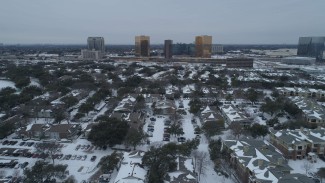Washington, DC—Rather than build new power plants at high cost, Texas could avert future blackouts at a lower price by instead improving the energy efficiency of its homes and using technologies to shift electricity use away from times of peak demand, according to a report released today by the American Council for an Energy-Efficient Economy (ACEEE).
The report arrives as Texas policymakers, regulators, and utilities seek to address electric reliability challenges in the wake of Winter Storm Uri. It shows that wide-scale efficiency and demand response investments through utility programs could provide the same degree of added reliability as proposed gas plants for at least 39% lower cost—not even accounting for the operations and maintenance costs of those plants.
Extreme temperatures can not only shut down some power generators but also cause electric demand to spike as residents crank up the heat or air-conditioning. Those spikes can be acute in Texas, where the most common type of home heating is inefficient electric furnaces and half of single-family houses have inadequate attic insulation, according to federal data.
“Electric demand is always going to go up when there’s hot or cold weather, but it’s a manageable problem if you have efficient houses,” said Steven Nadel, executive director of ACEEE and lead author of the report. “Wasting electricity in Texas when power demand is peaking just doesn't make sense. Home efficiency upgrades and technology that shifts when electricity is used simply costs less than building new plants, and we have the numbers to prove it.”
ACEEE modeled the potential impact of Texas’s electric utilities expanding their programs (and creating new programs) that incentivize homeowners to upgrade from electric furnaces to efficient heat pumps when existing systems need to be replaced, improve attic insulation and duct sealing, switch to smart thermostats, and install heat pump water heaters. ACEEE also considered three potential demand response programs, in which electric customers are provided an incentive to allow their utility to shift when their central air conditioners, water heaters, and electric vehicle chargers are used away from times of the highest stress on the power system.
The 7 programs, deployed aggressively under Public Utility Commission direction over 5 years (beginning in 2023), could offset about 7,650 MW of summer peak load and 11,400 MW of winter peak load, ACEEE found. This approximately equals the electricity that would be generated under 2 separate private proposals this year to build 10 or 11 new gas power plants that would be used at peak times.
While the gas plants would cost $8 billion, the efficiency and demand response measures would have a 5-year total programmatic cost of about $4.9 billion, or 39% less. They would also fully avoid the power plants’ additional costs for fuel, maintenance, and transmission infrastructure.
And while new power plants might only be put to use during peak power demand events, efficiency programs would reduce energy bills for many Texans year-round. Some of the modeled programs would also make homes healthier and safer for residents.
The ACEEE report focuses on single-family homes and multifamily buildings because during recent summer and winter times of peak electric demand, the residential sector accounted for about half of recent temperature-sensitive peak loads. Other policies not examined in the report could unlock additional demand reductions through cost-effective efficiency and demand response in the commercial and industrial sectors.
